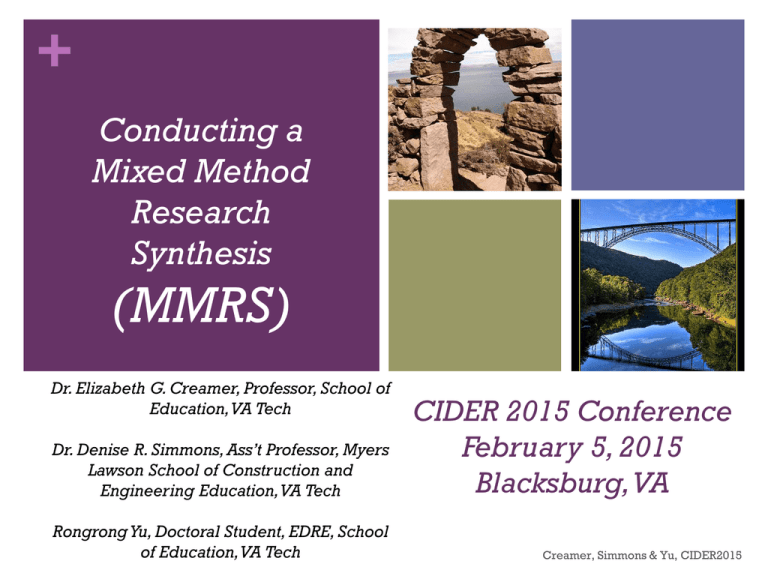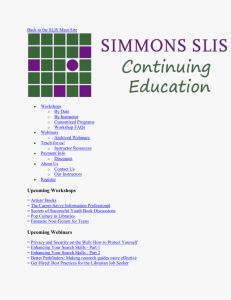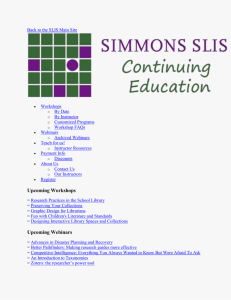the procedures of a mixed methods
advertisement

+ Conducting a Mixed Method Research Synthesis (MMRS) Dr. Elizabeth G. Creamer, Professor, School of Education, VA Tech Dr. Denise R. Simmons, Ass’t Professor, Myers Lawson School of Construction and Engineering Education, VA Tech Rongrong Yu, Doctoral Student, EDRE, School of Education, VA Tech CIDER 2015 Conference February 5, 2015 Blacksburg, VA Creamer, Simmons & Yu, CIDER2015 + Overview of Topics Covered 1. Describe types and purposes of systematic reviews (SR) of the literature. 2. Review stages in the process a SR. 3. Distinguish QUAL, QUANT, and MM reviews 4. Provide an example of a MMRS 5. Summarize the value-added by a mixed method approach. 6. Identify challenges to systematic reviews 7. Suggest avenues for future research. Creamer, Simmons & Yu, CIDER2015 + Defining Mixed Methods Research: Mixing at Any of 4 Stages QUAL Research Question/Desig n Data Sampling or Analysis Synthesis or Visualization Creamer, Simmons & Yu, CIDER2015 QUANT MM + How Much of the Research Literature in Education is Mixed Methods? Discipline Research Studies (n=2381) MM Studies (n=332 (14%)) Literacy 424 66 (16%) Mathematics 617 86 (14%) Science 1182 167 (14%) Social Studies 158 13 (8%) Reference: Truscott et al., 2010 Creamer, Simmons & Yu, CIDER2015 + Systematic Literature Reviews – 4 Design Choices Type of datanumbers or words Articles to ReviewQUAL, QUANT, and/or Mixed Creamer, Simmons & Yu, CIDER2015 Type of analytical procedures-QUAL, QUANT, or both Ways to visualize – words, numbers or both + Definition – Research Synthesis A systematic review or research synthesis is a type of literature review that uses systematic procedures to synthesizes the literature in order to pool or aggregate the results or to evaluate quality features. Mixed methods research synthesis(MMRS)-review includes empirical articles using qualitative, quantitative, and mixed methods The goal in this type of research is to generalize results across studies and to produce a synthesis that combines words and numbers. Creamer, Simmons & Yu, CIDER2015 + Different Terms Distinguish QUAL, QUANT, and MIXED Research Synthesis Analytical Logic Descriptors QUALITATIVE Research Synthesis, Meta Narrative, Meta Ethnography, Case Narrative QUANTITATIVE Meta-synthesis MIXED METHODS Mixed method research synthesis Mixed method mixed research synthesis* Integrative mixed method review Creamer, Simmons & Yu, CIDER2015 + GENERIC STAGES Sandelowski et al., (2012, p. 320) identified the following generic steps in conducting a synthetic review. 1. Define the research purpose and questions. 2. Set parameters for a systematic literature search, including criteria for inclusion and exclusion, and conducting the search. 3. Identify categories, themes, and/or relationships about results or outcomes using using either an inductive or deductive approach. 4. Summarize result by counting, plotting (as through cluster analysis), using figures, or a narrative summary. Creamer, Simmons & Yu, CIDER2015 + Sampling in Systematic Reviews Both purposeful (QUAL) and exhaustive (QUANT) Goal: 20-40 articles for a mixed method review Creamer, Simmons & Yu, CIDER2015 + Value Added of a MM Approach to an Outcome Oriented Review VERY persuasive foundation for a grant proposal or publication. Offers the potential to compare outcomes for different groups of students and by type of activity. Can be used to answer how and why questions and to summarize the literature as a causal model. Creamer, Simmons & Yu, CIDER2015 STEP 1 of ANALYSIS: Data Reduction Kearney, M. H. (2001). Enduring love: A grounded formal theory of women’s experience with domestic violence. Research in Nursing & Health, 24, 270282. Creamer, Simmons & Yu, CIDER2015 + Data Matrix - Another Type of Data Consolidation Theme 1 Article 1 XXX Article 2 Article 3 Theme 2 XX XXXX X Article 4 Creamer, Simmons & Yu, CIDER2015 Theme 3 XX XX X LAST STEP: VISUAL/GRAPHIC DISPLAY – A GT LOGIC DIAGRAM Whittemore, R. (2005). Analysis of integration in nursing science and practice. Journal of Nursing Scholarship, 37(3), 261-267. Creamer, Simmons & Yu, CIDER2015 ANOTHER EXAMPLE OF A VISUAL DISPLAY – A CONCEPT MAP From: Attride-Stirling, 2001, p. 388 Creamer, Simmons & Yu, CIDER2015 + CAREER: Investigating Co-Curricular Participation of Students Underrepresented in Engineering, Dr. Denise Simmons, PI The authors would like to gratefully acknowledge the National Science Foundation for their support of this work under the CAREER grant #EEC1351156. Any opinions, findings, conclusions, or recommendations expressed in this presentation are those of the authors and do not necessarily reflect the views of the National Science Foundation. Creamer, Simmons & Yu, CIDER2015 + Background of Project Specific outcomes result from involvement in “out of class” experiences Engineering students are less likely to participate Few studies investigate participation decisions of engineering related to these experiences various types activities when investigating student outcomes Develop survey to collect data and investigate gaps Mixed Method Research Synthesis Creamer, Simmons & Yu, CIDER2015 + Research Questions for Co-Curricular Involvement Project Who benefits from participation in co-curricular activities? What factors influence students’ decision to participate or not participate in the co-curricular activities? What are the outcomes of participating in the co-curricular activities? Does the impact of co-curricular activities vary by types of activities? How does co-curricular activities influence students’ learning outcomes, persistence in their majors, and career intentions? Creamer, Simmons & Yu, CIDER2015 + Conceptual Framework for Mixed Method Research Synthesis Four steps: information extraction, inductive analysis, cluster analysis, and analysis of outcomes Creamer, Simmons & Yu, CIDER2015 + Steps Data collection: identified 51 articles with 36 quantitative studies, 7 qualitative studies, and 8 mixed methods studies. Information extraction: (1) identified the outcomes related to co-curricular involvement; and (2) extracted the information using NVIVO 10. Creamer, Simmons & Yu, CIDER2015 + Steps Data analysis—inductive (qualitative) phase (1) generated descriptive codes through a process of open coding (2) organized the initial codes into groups and developed categories with a higher level of abstraction Creamer, Simmons & Yu, CIDER2015 + Data Consolidation & Comparison (1) Cluster analysis: grouping categories into clusters by the words similarity Creamer, Simmons & Yu, CIDER2015 + Steps Data analysis—deductive (quantitative) phase (2) Quantizing the results: sort and count the clusters by types of co-curricular activities Outcomes Frequency (Percentage) Rank Intellectual development Personal and social development Civic development Interpersonal development Career and professional development Satisfaction with college experiences Academic and social engagement Belonging and persistence in the major 23 (51.1%) 11(24.4%) 2(4.4%) 6(13.3%) 13(28.9%) 3(6.7%) 10(22.2%) 9(20.0%) 1 3 8 6 2 7 4 5 Creamer, Simmons & Yu, CIDER2015 + Systematic Reviews: Challenges 1. There’s no way you can use this method if you are squeamish about associating numbers with qualitative data or if you see qualitative and quantitative methods as polar opposites. 2. Getting an adequate sample size (20-40) of articles on the same construct or intervention to conduct statistical procedures. 3. Developing creative figures/models/visualizations. 4. Examples of a mixed methods mixed synthesis (MMMR) are few and far between. Creamer, Simmons & Yu, CIDER2015 + Discussion Questions: Innovative Approaches to Research Synthesis What applicability do you see from what we have talked about to your own research? How could you do a systematic review AFTER you’ve completed a traditional literature review chapter for your chapter? Creamer, Simmons & Yu, CIDER2015 + Making Your Mark in Systematic Reviews A Systematic Review Squared (MRS-squared) 1. Develop a grounded theory from a review of the literature about how and why an outcome like engagement or interest in STEM is promoted. 2. Use a QUAL approach to identify the methodological and graphic characteristics of top-cited articles (ie. More than 50 cites in 5 years) in your field Or reviews published in the Review of Educational Research Or the visualizations (e.g. figures and tables) presented in these Creamer, Simmons & Yu, CIDER2015 + Relevant References Attride-Stirling, J. (2001). Thematic networks: An analytical tool for qualitative research. Qualitative Research, 1(3), 385-405). Kearney, M. H. (2001). Enduring love: A grounded formal theory of women’s experience with domestic violence. Research in Nursing & Health, 24, 270-282. Onwuegbuzie, A. J., & Teddlie, C. (2003). A framework for analyzing data in mixed methods research. In A. Tashakkori and C. Teddlie (Eds.), Handbook of mixed methods in social and behavioral research (pp. 351-383). Thousand Oaks, CA.SAGE. Sandelowski, Voils, Leeman, & Crandall. (2012). Mapping the mixed methodsmixed research synthesis terrain. Journal of Mixed Methods Research, 6 (4), 3-17221. Whittemore, R. (2005). Analysis of integration in nursing science and practice. Journal of Nursing Scholarship, 37(3), 261-267. Creamer, Simmons & Yu, CIDER2015



